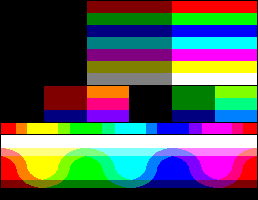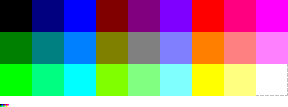m |
m (→Colour Palette) |
||
| (10 intermediate revisions by the same user not shown) | |||
| Line 14: | Line 14: | ||
* It shares a few similarities with Amstrad CPC, mostly its CPU and Colour Palette. | * It shares a few similarities with Amstrad CPC, mostly its CPU and Colour Palette. | ||
| + | |||
| + | * The video modes in 8 displayble inks is somewhat typical from Japanese machines, as for the NEC PC8000 series, also hogh resolution (sort of) in order to display Kanjis and asian characters more easily. | ||
== Photo == | == Photo == | ||
| Line 42: | Line 44: | ||
|} | |} | ||
| + | But according to videos the palette seems to be the result of the 8 colours RGB + hi-resolution ditherings, hence being a Software palette. | ||
| + | |||
| + | {{#ev:youtube|wpA2XGqE38I|420}} | ||
| + | |||
| + | * From the demo we can see that the Pasopia 7 is able to produce the 27 colours via vertical lines in 640x200 video of the basic RGB 8 colours. | ||
| + | |||
| + | While this is visible on modern emulation and modern monitors, this would actually produce real solid extra colours on a CRT monitor. | ||
| + | |||
| + | To dither finely the 8 RGB colours cannot produce more than 27 colours because of redundancy in the result colour from diferent combinaison. | ||
| + | |||
| + | *Opposite colours from the 2x2x2 (1bit) RGB cube would produce grey | ||
| + | Ex : Black + White = grey, Yellow + Blue = Grey. | ||
| + | |||
| + | *some other mix would produce already existing basic colours | ||
| + | Ex : Red + Blue = Magenta, Red + Green = Yellow. | ||
| + | |||
| + | * would only remain : | ||
| + | = 6 intermediary colours : Lime, sky blue, Purple, Sea Green, Orange, Lavender. | ||
| + | |||
| + | = Darker Basic colours when mixed with Black : Dark blue, Dark Red, Dark Cyan...and so on. | ||
| + | |||
| + | = Lighter basic colours when mixed with White : Light red, Light Cyan... equivalent to Amstrad CPC's Pastel colours. | ||
| + | |||
| + | This leads to the 3-level RGB cube generated from the 1-bit RGB cube in high horizontal resolution and CRT monitor effect. | ||
| + | |||
| + | * The same trick may be somewhat possible on the Sinclair QL (256x256x8 may work, 512x256x4 would produce some part of the CPC palette) or NEC PC-8801 (640x200x8) or any machine with basic 1bit (2 levels) RGB palette and 640x200 resolution, using CRT monitor. | ||
== Links == | == Links == | ||
| Line 51: | Line 79: | ||
* Old-Computer.com : [[http://www.old-computers.com/museum/computer.asp?c=413&st=1 there]] | * Old-Computer.com : [[http://www.old-computers.com/museum/computer.asp?c=413&st=1 there]] | ||
| − | + | * VintageCPU :[[https://vintagecpu.wordpress.com/toshiba-pasopia-7/ there]] | |
[[Category:Non CPC Computers]] | [[Category:Non CPC Computers]] | ||
[[Category:CP/M]] | [[Category:CP/M]] | ||
Latest revision as of 22:56, 8 November 2014
The PASOPIA 7 is a computer manufacture by Toshiba and sold in 1983, most probably only in Japan.
Facts
- This is the successor of the Pasopia 5. It has improved sound and graphics.
- A cool feature was it was sold with three interchangeable colored panels, so it was possible to change the color of your computer any time you liked. There were blue, red and black panels.
- The Pasopia line would also include MSX models
- Being Z80A based, the Passopia 7 is compatible with CP/M
- Like most of those Japanese machines, it is almost unknown in Western world.
- It shares a few similarities with Amstrad CPC, mostly its CPU and Colour Palette.
- The video modes in 8 displayble inks is somewhat typical from Japanese machines, as for the NEC PC8000 series, also hogh resolution (sort of) in order to display Kanjis and asian characters more easily.
Photo
System Specifications
- Name = Toshiba Pasopia 7 or PA-7007
- Released = 1983
- Discontinued = Probably
- Processor = Zilog Z80A
- Memory = 64 kb RAM, 56 kb VRAM
- graphics = 320 x 200 x 8 colours and two screens / 640 x 200 x 8 colours and two screens ; 3-level RGB palette
- sound = TI SN76489 :2 voices, 6 octaves or 6 voices, 5 octaves and 2 noise channels (depends on sources informations)
- OS = T-Basic 7, CP/M optional
- predecessor = Toshiba Pasopia 5
Colour Palette
- This computer is one of the rare ones to use the 3-level RGB palette, the same as the Amstrad CPC.
But according to videos the palette seems to be the result of the 8 colours RGB + hi-resolution ditherings, hence being a Software palette.
{{#ev:youtube|wpA2XGqE38I|420}}
- From the demo we can see that the Pasopia 7 is able to produce the 27 colours via vertical lines in 640x200 video of the basic RGB 8 colours.
While this is visible on modern emulation and modern monitors, this would actually produce real solid extra colours on a CRT monitor.
To dither finely the 8 RGB colours cannot produce more than 27 colours because of redundancy in the result colour from diferent combinaison.
- Opposite colours from the 2x2x2 (1bit) RGB cube would produce grey
Ex : Black + White = grey, Yellow + Blue = Grey.
- some other mix would produce already existing basic colours
Ex : Red + Blue = Magenta, Red + Green = Yellow.
- would only remain :
= 6 intermediary colours : Lime, sky blue, Purple, Sea Green, Orange, Lavender.
= Darker Basic colours when mixed with Black : Dark blue, Dark Red, Dark Cyan...and so on.
= Lighter basic colours when mixed with White : Light red, Light Cyan... equivalent to Amstrad CPC's Pastel colours.
This leads to the 3-level RGB cube generated from the 1-bit RGB cube in high horizontal resolution and CRT monitor effect.
- The same trick may be somewhat possible on the Sinclair QL (256x256x8 may work, 512x256x4 would produce some part of the CPC palette) or NEC PC-8801 (640x200x8) or any machine with basic 1bit (2 levels) RGB palette and 640x200 resolution, using CRT monitor.


